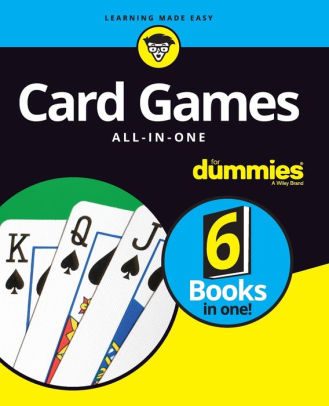Gin Rummy Rules For Dummies
Before a beginner learns how to play gin rummy and the tricks and tips in playing the game, one should be familiar with the common terms used associated with this card game. Gin rummy- is a card game that consists of two players (more in other variations). The sole objective of the players is to outdo each other's cards and score the higher points. In Grand Gin Rummy, a green knock button will appear. The scores are tallied with each player’s hand face-up on the table. Add up your points of deadwood and subtract it from your opponent’s deadwood. Whatever number you get is your score for that round. Gin Rummy Rules for Dummies February 24, 2018 Categories: Card Games, Download Rummy Game, Free Rummy, Indian Rummy, Playing Rummy, Rummy Cash Games This particular post helps in the below way: About Gin Rummy How to play Gin Rummy & Rules Where to play Gin rummy & how to download on mobile.
- Gin Rummy Rules For Dummies Free
- Gin Rummy Rules For Dummies Pdf
- How To Play Gin Rummy Simple
- Gin Rummy Rules Explained
Gin Rummy was created with the intention of being faster thanStandard Rummy and related games. The rules are very easy to learn as itis simply a matter of the draw and discard, without the complications attachedto displaying melds and laying off cards between turns. Both of these things aredone at the end of a hand and Gin Rummy is often played without any kind oflaying off making for a 'quick fire' game.
Setup
Players: Typically just two players, however there are other Gin games thatcan accommodate 3 or 4 players.
Cards: One standard 52-card deck, with no jokers or other wild cards. Acesare always used as a low card with a value of 1.
The Deal: Each player is dealt 10 cards, and the next card is turned up tobecome the start of the discard pile.
Objective: The purpose of the game is to complete a hand consisting of mostor all of the cards formed into Sets and/or Runs.
Game Play
During the turn-by-turn play of Gin Rummy there is no laying down of melds orlaying off of cards onto other melds. The cards are held in the players haduntil they are ready to go out, at which point the player will display theirmelds and the other player will have the opportunity to lay off. The playersturns prior to being ready to go out are basically just drawing and discardingcards, one at a time.
Draw: The player must take just one card either from the discard pile or thestock pile and add this card to the 10 cards that comprise his hand. The discardpile is face up so the other player will know what card he took. If that playerchooses to take from the stock, his opponent will not see the card (since cardson the stock pile are face down).
After the player has taken one card, he must now study his cards and decidewhich one is the card he needs least of all – a card that is probably not insequence with the rest or is the only one of its kind making it nearlyimpossible to form either a set or run. The next step is:

Discard: The player must then take this card out of his collection and putit on the discard pile, face up.
Note that according to official Gin Rummy rules the players draw in a specialway during the first round. The person who did not deal out the cards has thefirst choice. He can take the face up card from the discard pile if he wants to.If not, the other player can take it and if the other player does not want iteither, the person who did not deal gets the first chance to draw the top cardfrom the stock pile.
Stock Pile Exhausted
The game ends if there are only two cards left on the stock pile and the playerwho took the third to the last card on the pile discards a card withoutknocking. In this situation, there is no winner and another round can begin.
End of Hand
The Gin Rummy game ends as soon as one player has formed all or most of theircards into melds (Sets or Runs) and lays them all down on the table or in adesignated meld area on the table for his opponent to see followed by him or herdiscarding their last card to signal victory. When the player goes out in thismanner, it is called 'Knocking' – a traditional symbolic gesture to announcevictory to an opponent. Today, it is customary to throw the final card on thetable (traditionally face down) to signal victory.
According to the official Gin Rummy rules a player may only Knock if they have10 points or less of deadwood (i.e. unmatched or unmelded cards). For example,he can knock if his deadwood is A-3-4 as the total value ofthose cards is 8 points, which is less that the 10 point minimum.
After a player knocks the other player must now expose his cards, placing hismelds on the table. He is also allowed to take any of his deadwood (unmeldedcards) to add to the sets or runs laid down by the knocker. For example, hemight add a fourth card of the same rank to a group of three or more consecutivecards of the same suit to either end of a sequence. This is known as 'layingoff'. The player may only lay off cards that are deadwood, not cards that he hasalready formed into melds. The player who knocked is not allowed to lay off anyof his or her own deadwood cards, even if it would appear that thay becomeplayable due to the other player's lay offs.

Knocking is not mandatory. A player can choose to continue taking turns even iftheir deadwood count is below 10. If the player is able to Knock when all oftheir cards are melded, plus one to discard, then instead of knocking theydeclare 'Gin' and lay down their melds and discard. When a player has gone 'Gin'they receive a 20 point bonus and the other player is not allowed to lay off anyof their deadwood. This means that there is a big incentive to try for Gininstead of knocking as soon as you can.
Scoring

Each player totals the value of their deadwood cards, based on the followingvalues. Aces are always low (ranking below a 2) and therefore have a value of 1.
/412366-gin-rummy-complete-card-game-rules_05-5b0e9ebf119fa800376d86ce.gif)
| Card | Value |
|---|---|
| Ace | 1 |
| Face cards | 10 |
| Others | Face value |
Knock Scoring: If the knocker has a lower deadwood count then he or shereceives the difference between their deadwood and the other player's deadwood.
Undercut Scoring: If the knocker does not go Gin, and his deadwood tally isequal to or higher than his opponent, this means the knocker has been 'undercut”. His opponent scores the difference between the two counts and also receives abonus of 10 points. For example, the the knocker has a deadwood total of 8, andthe opponent has a deadwood count of 3, the opponent receives a score of 15 (8 -3 + 10) and the knocker receives no points.
Gin Scoring: A player who goes Gin scores a bonus 20 points, plus theopponent's deadwood count, if any. A player who goes Gin can never be undercut.Even if the other player has no deadwood, the player who goes Gin gets the bonusand the other player gets nothing.
Game Bonus: Players keep dealing the cards for subsequent hands until onereaches a score of 100 or other designated (pre agreed) target score. The firstplayer to reach a score of 100 points receives a 'game bonus' of 100 points.
Gin Rummy Rules For Dummies Free
Line Bonus: In addition, each player earns a 20 point bonus for every handwon. This is known as the line bonus or a box bonus. These are not countedtowards the 100 points required to win a game of Gin Rummy.
Optional Rules and Variations
The following rules may be added to the standard game if players agree to thevariation before the first player takes their turn. It’s not an all or nothingdeal, the game participants can pick and choose which variations they like.
Gin Rummy Rules For Dummies Pdf
- No laying off: Some play Gin Rummy with no laying off and scoring happensas soon as a player knocks or goes gin.
- No discard of drawn card: It is common to not allow a player to discardthe same card they drew from the discard pile at the start of their turn. Inother words, be sure you really want the card before drawing it from the discardpile.
- Undercut and gin bonus: There are some variations on the bonuses givenfor going gin or for undercutting. The actual values don't really mattermuch, just agree before playing what they will be. Common values other thanthose mentioned above are 25 for the gin bonus and 20 for the undercut bonus.
- Blitz: If the loser of the game has won no hands at all then the resultis called a 'Blitz' or a 'Schneider' and the winner's score and game bonus,but not the line bonuses, are doubled.
- Only Runs: In this variation of Gin Rummy only melds consisting of runsare allowed. Sets of 3 or 4 of a kind are not.